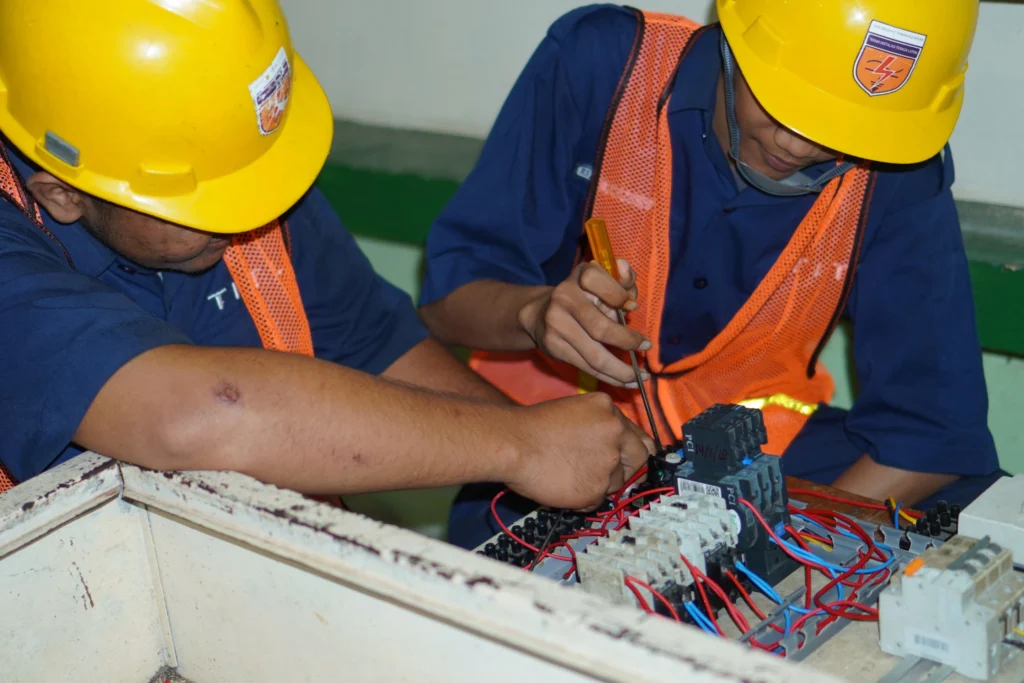INTRODUCTION FOR HOBO – ELECTRICAL SAFETY TRAINING
This 2-day HOBO Electrical Safety Training typically covers basic electrical knowledge, hazard recognition, and safety procedures. It includes theoretical learning and practical exercises, covering topics such as understanding electrical safety concepts, identifying electrical hazards, and implementing lockout/tagout (LOTO) procedures.
LEARNING OBJECTIVES
To enhance knowledge and skills in the following areas:
- Fundamentals of electricity.
- Raise awareness of potential electrical hazards.
- Electricity and its dangers.
- Understanding electric shocks and electric burns.
- Knowing the electrical safety model.
- Ways to recognize hazards.
- Knowing safe working environments.
- Low Voltages.
- High Voltages.
- Electrical grounding.
- Safe work practices.
- How to recognize electrical hazards.
- Provide ways to eliminate, remove, and prevent electrical hazards in the workplace.
- Emphasizing the extreme importance of observing all electrical safety requirements and practices.
- What to do in the event of an electrical accident.
- Visual management – Electrical safety posters and symbols.
- Fostering a safety culture.
WHO SHOULD ATTEND
Non-Technical employees, Contractors, Foreign workers.
LEARNING METHODOLOGY
The training will comprise 70% theory and 30% group discussions with Q&A sessions and best practices video presentations.
COURSE CONTENT
Day 1: Training Topics: 9.00am to 5.00pm
- Pre Test Assessment – Electrical Safety
- Module 1: Introduction to Electrical Safety:
- Overview of the importance of electrical safety and legal requirements.
- Fundamentals and Theory.
- Overview of electrical hazards and their impact on the workplace.
- Understanding the importance of electrical safety regulations and standards.
- Defining HOBO roles and responsibilities.
- Exercise 1: List down all dangers and incidents regarding electrical safety at the workplace.
- Module 2: Basic Electricity Concepts:
- Voltage, current, resistance, and power.
- Direct Current (DC) and Alternating Current (AC).
- Understanding electrical circuits.
- Electrical Hazards and Risk Assessment:
- Identifying potential electrical hazards in the workplace.
- Understanding the effects of electrical shock on the body.
- Risk assessment and control measures.
- Exercise 2: Every employee must adhere to all basic electricity hazards. What are they in your work area?
- Module 3: Safe Work Practices:
- Working and Workplace Safety.
- Hazards and Dangers of Electricity.
- Prevention, Substitute, Control, and PPEs.
- Personal Protective Equipment (PPE) types.
- Safe work procedures for electrical equipment.
- Lockout/Tagout (LOTO) procedures.
- Discipline and developing Safe Work Practices and Safety rules.
- Exercise 3: Name all safe work practices all must follow.
- Module 4: Key Concepts and Considerations:
- Qualified vs. Unqualified Persons: Understanding the differences and the appropriate safety measures for each.
- Short Circuits and Arcing: Understanding the risks associated with short circuits and arc flash.
- Safe Working Practices: Following established procedures when working near live electrical equipment.
- Emergency Procedures: Knowing how to respond to an electrical accident or emergency.
- Module 5: Practical Demonstrations:
- Hands-on demonstration of electrical safety equipment and procedures.
- Using safety tools. Practical Applications.
- Emergency Responses – First Aids – CPR – Practical demonstration.
Day 2: Training Topics – 9.00am to 5.00pm
- Revision – Day 1 lessons recap
- Module 6: Advanced Electrical Safety Concepts:
- Understanding different types of electrical systems and equipment.
- Specific safety requirements for various work environments.
- Emergency procedures in case of an electrical accident.
- Fire evacuation drills.
- Key Concepts and Considerations:
- Qualified vs. Unqualified Persons: Understanding the differences and the appropriate safety measures for each.
- Short Circuits and Arcing: Understanding the risks associated with short circuits and arc flash.
- Safe Working SOPs: Following established procedures when working near live electrical equipment.
- Emergency Procedures: Knowing how to respond to an electrical accident or emergency.
- Module 7: Workplace Visit – Electrical Safety Observations and Data Collection:
- Warehouse, Stores, IQC, Parts Kitting, Machines, Process, Final assembly, Packing.
- Simulating lockout/tagout procedures.
- Practicing emergency response and Safety posters.
- Understanding LOTO signages and strictly following instructions.
- Energy Monitoring: Energy efficiency and safety practices.
- HOBO loggers – Monitor energy consumption and identify areas where energy usage can be reduced.
- Exercise 4: Hands-on exercises on Energy Consumptions, Safety, and Efficiency.
- Module 8: Electrical Safety Evaluation and Assessment:
- Safe Work Practices.
- How Do You Work Safely?
- Plan Your Work and Plan for Safety.
- Avoid Wet Working Conditions and Other Dangers.
- Avoid Overhead Powerlines.
- Use Proper Wiring and Connectors.
- Use and Maintain Tools Properly.
- Hazards evaluation – Electrical circuits.
- Lock Out Tag Out – LOTO working principles.
- 7 QC Tools – Interpretation and Understanding.
- Reports and Documentation – Bulletin Boards.
- Fostering the Safety Culture.
- Exercise 5: Discuss all aspects of safe work practices and the risks involved if not followed.
- Module 9: Conclusion:
- Training summary.
- Post Test Assessment: HOBO Electrical Safety.
- Training evaluation.
- Q&A.
Training Duration
2 days (9am – 5pm)


